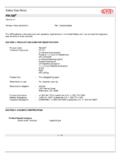Transcription of Halotron-1 (Fire Extinguishing Agent)
1 MATERIAL SAFETY DATA SHEET Halotron-1 ( fire Extinguishing agent ) Revision Date: February 9, 2015 Page 1 of 7 1. IDENTIFICATION OF THE SUBSTANCE/PREPARATIONS AND OF THE COMPANY UNDERTAKING Product Name Halotron-1 ( fire Extinguishing agent ) Other Trade Names HCFC Blend B, Halocarbon agent Product Description fire Extinguishing agent Manufacturer/Supplier Badger fire Protection Address 944 Glenwood Station Lane, Suite 303 Charlottesville, VA 22901 USA Phone Number (434)-964-3200 Chemtrec Number (for emergencies only) (800) 424-9300 (703) 527-3887 (International) Revision Date.
2 February 9, 2015 MSDS Date: January 15, 2007 Safety Data Sheet according to EC directive 2001/59/EC and OSHA s Hazcom Standard (29 CFR ) 2. HAZARDS IDENTIFICATION EU Main Hazards Non Flammable Gas Routes of Entry Eye contact - Inhalation - Skin contact Carcinogenic Status Not considered carcinogenic by NTP, IARC, and OSHA. Target Organs Respiratory System - Eye - Cardiovascular System - Central Nervous System - Liver Health Effects - Eyes Direct contact with the cold liquid or gas may cause irritation with discomfort, tearing or blurring of vision.
3 Health Effects - Skin Direct contact with the cold gas or liquid can cause cooling of exposed tissues. Health Effects - Ingestion Ingestion is not likely to occur during normal handling and use. Health Effects - Inhalation Short term exposure to vapor at high concentrations have the following effects: light headedness - dizziness - difficulty with breathing - drowsiness - nausea - mental confusion irregular pulse - palpitations - loss of consciousness and death. Chronic overexposure may adversely affect the liver. Individuals with pre-existing disease of the central nervous system, cardiovascular system and liver will be at increased risk.
4 3. COMPOSITION/INFORMATION ON INGREDIENTS Component Name CAS#/Codes Concentration R Phrases EU Classification 2,2-dichloro-1,1,1-trifluoroethane 306-83-2 EC#206-190-3 >93% None Non Flammable Gas MATERIAL SAFETY DATA SHEET Halotron-1 ( fire Extinguishing agent ) Revision Date: February 9, 2015 Page 2 of 7 Proprietary gas mixture <7% None None 4. FIRST AID MEASURES Eyes Immediately flood the eye with plenty of warm water for at least 15 minutes, holding the eye open. Obtain medical attention if soreness or redness persists.
5 Skin For general skin exposure, apply large amounts of water. If frostbite occurs, gently warm affected areas. Obtain medical attention if blistering occurs or redness persists. Ingestion Do not induce vomiting. Dilute by drinking large quantities of water and obtain medical attention. Inhalation Remove from exposure. If there is difficulty in breathing, give oxygen. Obtain medical attention immediately. Advice to Physicians Treat symptomatically. 5. fire - FIGHTING MEASURES Extinguishing Media Halotron-1 is used as an Extinguishing agent and therefore is not a problem when trying to control a blaze.
6 Use Extinguishing agent appropriate to other materials involved. Keep containers and surroundings cool with water spray as containers may rupture or burst in the heat of a fire . The concentrated agent when applied to fire can produce toxic by-products specifically hydrogen halides which can cause damage. Avoid inhalation of these materials by evacuating and ventilating the area. Unusual fire and Explosion Hazards Containers may explode in heat of fire . Protective Equipment for fire -Fighting Wear full protective clothing and self-contained breathing apparatus as appropriate for specific fire conditions.
7 6. ACCIDENTAL RELEASE MEASURES Wear full protective clothing and self-contained breathing apparatus. Remove leaking cylinder to a safe place. Ventilate the area. Vapors can accumulate in low areas. Confined spaces should only be entered using a self-contained breathing apparatus. 7. HANDLING AND STORAGE Cylinders should be properly stored and secured to prevent falling or being knocked over. Do not drag, slide or roll cylinders. Do not drop cylinders or permit them to strike against each other.
8 Never apply flame or localized heat directly to any part of the cylinder. MATERIAL SAFETY DATA SHEET Halotron-1 ( fire Extinguishing agent ) Revision Date: February 9, 2015 Page 3 of 7 8. EXPOSURE CONTROLS/PERSONAL PROTECTION Occupational Exposure Standards Workplace Environmental Exposure Level (chronic handling) WEEL(AIHA)(8 hrs): 50 ppm (v/v), based on the primary component Manufacturer s Recommended 1 Hr. Emergency Exposure Limit: 1000ppm (v/v) Manufacturer s Recommended 1 Min. Emergency Exposure Limit: 2500ppm (v/v) Exposure Level When Using halotron I in a fire Extinguisher Exposure when using this material as a fire Extinguishing agent - the exposure should not exceed 20,000 ppm (v/v).
9 Guidelines for the safe minimum volume when this agent is used in a confined space are provided on the label of the extinguisher. Engineering Control Measures Use with adequate ventilation. There should be local procedures for the selection, training, inspection and maintenance of this equipment. When used in large volumes or odor becomes apparent, use local exhaust ventilation. Respiratory Protection Not normally required under conditions of use as a portable fire extinguisher. In areas where the agent concentration is above acceptable levels, use a self contained breathing apparatus, as an air purifying respirator will not provide protection.
10 Hand Protection Wear rubber gloves. Avoid contact with skin. Eye Protection Chemical goggles or safety glasses with side shields. Avoid contact with eyes. Body Protection Normal work wear. 9. PHYSICAL AND CHEMICAL PROPERTIES Physical State Pressurized Liquid Color Colorless Odor Slight ether Boiling Range/Point ( C/F) 27 Flash Point (PMCC) ( C/F) Not Flammable Solubility in Water wt @25oC/ 77oF, 1 atm. Relative Density (Air = 1) Vapor Pressure of Liquid ~ psig @ 68oF 77 kPa @ 20oC Liquid Density lb/ft3 @ 77 oF kg/l @ 25oC Gas Density ~ lb/ft3 ~ kg/m3 Evaporation Rate Not measured - readily volatilizes MATERIAL SAFETY DATA SHEET Halotron-1 ( fire Extinguishing agent ) Revision Date: February 9, 2015 Page 4 of 7 10.

